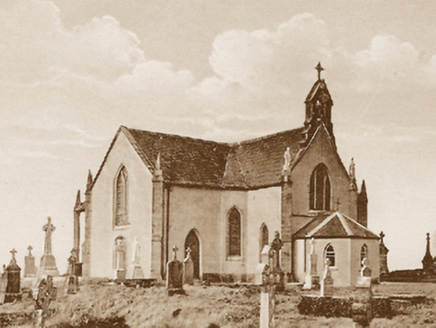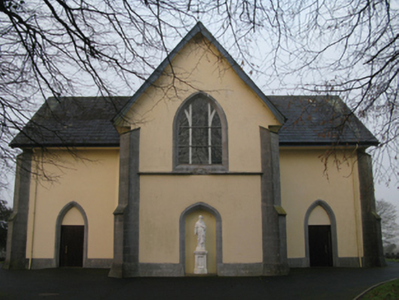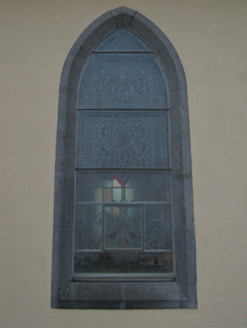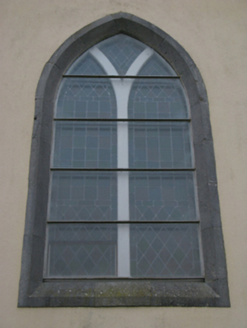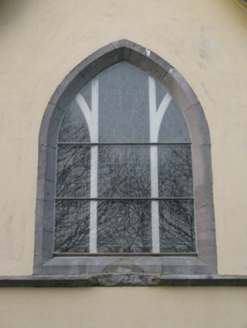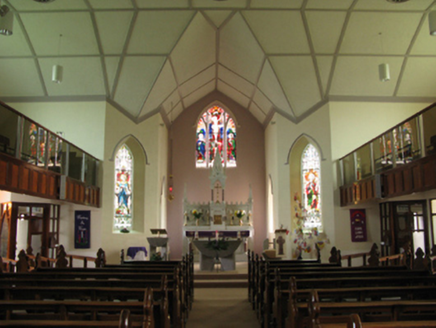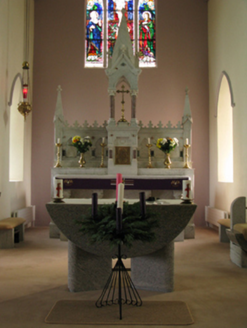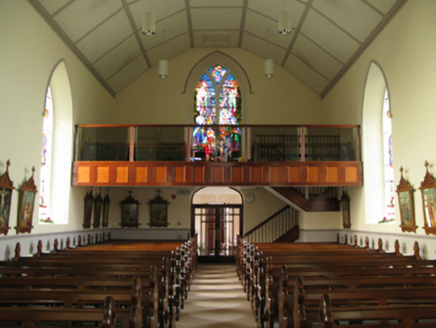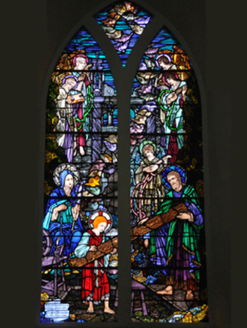Survey Data
Reg No
31311202
Rating
Regional
Categories of Special Interest
Architectural, Artistic, Historical, Social
Original Use
Church/chapel
In Use As
Church/chapel
Date
1830 - 1835
Coordinates
136621, 269422
Date Recorded
04/01/2011
Date Updated
--/--/--
Description
Detached three-bay double-height Catholic church, completed 1833; extant 1838, on a cruciform plan comprising single-bay double-height nave opening into single-bay (single-bay deep) double-height transepts centred on single-bay double-height chancel to crossing (east). Reconstructed, 1951. Renovated, 1994[?], with sanctuary reordered. Pitched slate roof on a cruciform plan with clay ridge tiles terminating in wrought iron Cross finials to apexes, scalloped timber bargeboards to gables, and replacement uPVC rainwater goods on timber eaves boards on overhanging rendered eaves retaining cast-iron downpipes. Cement rendered walls on drag edged tooled limestone ashlar battered plinth with tuck pointed drag edged tooled limestone ashlar diagonal stepped buttresses to corners having drag edged tooled cut-limestone coping. Lancet window openings with dragged cut-limestone surrounds having chamfered reveals framing storm glazing over fixed-pane fittings having stained glass margins centred on leaded stained glass pierced quatrefoils. Pointed-arch window openings to transepts with timber Y-mullions, and dragged cut-limestone surrounds having chamfered reveals framing storm glazing over fixed-pane fittings having stained glass margins centred on square leaded glazing bars. Lancet window openings to crossing (east) with dragged cut-limestone surrounds having chamfered reveals framing storm glazing over fixed-pane fittings having stained glass margins centred on leaded stained glass panels. Pointed-arch window opening to chancel (east) with timber mullions, and dragged cut-limestone surround having chamfered reveals framing storm glazing over fixed-pane fittings having stained glass margins centred on leaded stained glass panels. Lancet window openings to "cheeks" with dragged cut-limestone surrounds having chamfered reveals framing storm glazing over fixed-pane fittings stained glass margins centred on lattice glazing bars. Pointed-arch window opening to entrance (west) front with timber Y-mullion, and dragged cut-limestone surround having chamfered reveals framing storm glazing over fixed-pane fittings having leaded stained glass panels. Interior including vestibule (west); Tudor-headed door opening into nave with replacement glazed timber double doors having overlight; full-height interior with choir gallery (west) below stained glass memorial "West Window" (1927), central aisle between trefoil-detailed timber pews, Gothic-style timber stations centred on stained glass windows (1920), pair of stained glass memorial windows (1908) centred on carpeted stepped dais to sanctuary to crossing (east) reordered, 1994[?], with cut-veined white marble Gothic-style high altar below stained glass memorial "East Window" (1919), and polygonal vaulted ceiling in timber frame on stepped cornice. Set in landscaped grounds.
Appraisal
A church erected with financial support from the Brownes of nearby Castlemacgarrett regarded as an important component of the early nineteenth-century ecclesiastical heritage of south County Mayo with the architectural value of the composition, one recalling the contemporary Saint Joseph's Catholic Church (1830; reconstructed 1938-9), Shrule (see 31312211), confirmed by such attributes as the cruciform plan form, aligned along a liturgically-correct axis; and the "pointed" profile of the openings underpinning a streamlined Georgian Gothic theme with the chancel defined by a handsome "East Window": meanwhile, aspects of the composition, in particular the denuded roofline stripped of its bellcote and statue-topped pinnacles, clearly illustrate the near-total reconstruction of the church to a design by Edward Raphael Ryan (fl. 1933-64) of Galway (Irish Builder 1951, 248). Having been well maintained, the elementary form and massing survive intact together with quantities of the historic or original fabric, both to the exterior and to the interior reordered (1994) in accordance with the liturgical reforms sanctioned by the Second Ecumenical Council of the Vatican (1962-5) where contemporary joinery; vibrant stained glass supplied by Joshua Clarke and Sons (established 1892) of North Frederick Street, Dublin, including the jewel-like Corcoran Memorial "West Window" (1927); and a "flèche"-topped high altar, all highlight the artistic potential of a church making a pleasing visual statement in a rural village streetscape.
